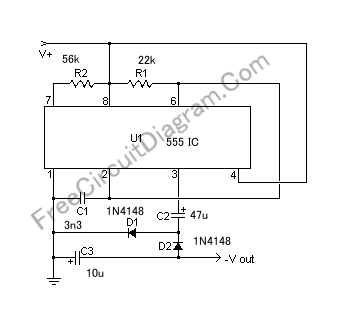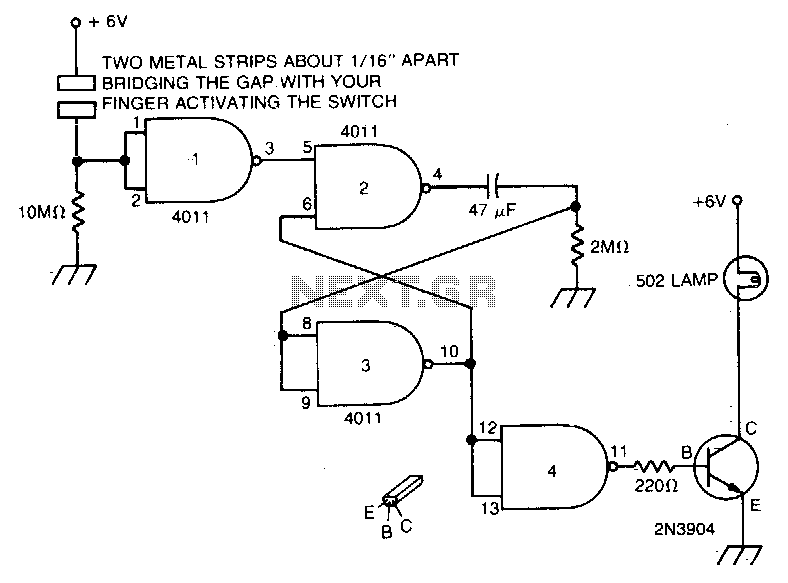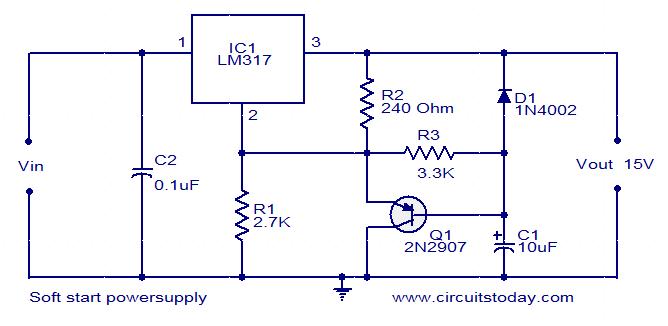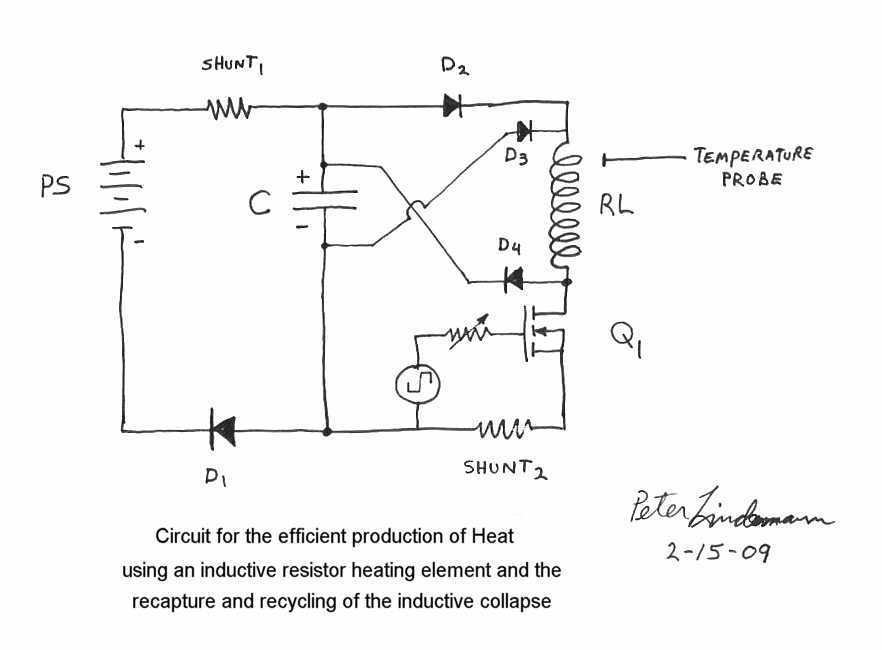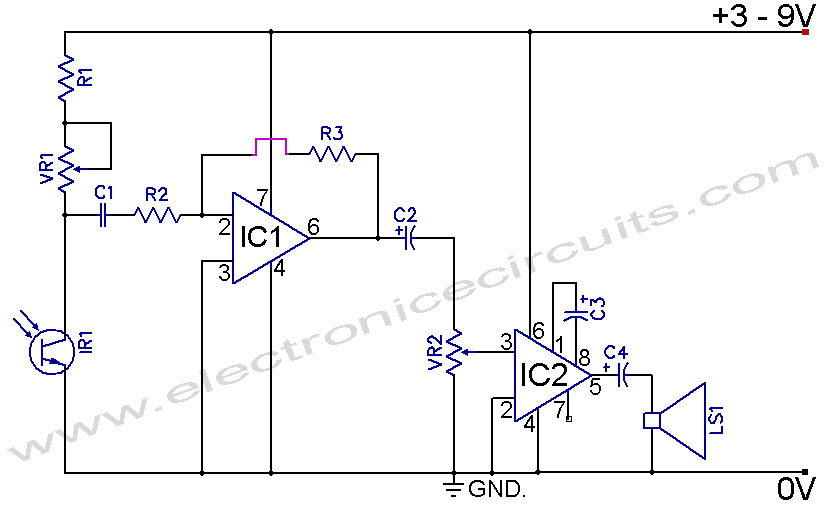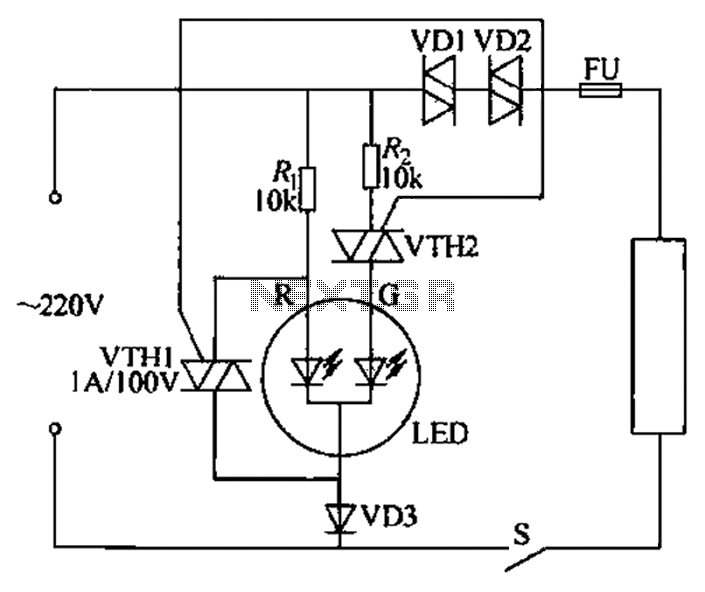
Light circuit diagram: Intelligent Electronic Lock
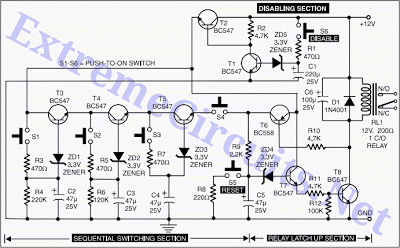
This intelligent electronic lock circuit is constructed using only transistors. To unlock this electronic lock, the user must press tactile switches S1 through S4 in sequence. For added security, these switches can be labeled with different numbers on the control panel or keypad. For instance, if a keypad with ten switches marked 0 through 9 is used, any four arbitrary numbers can be assigned to switches S1 through S4, while the remaining six numbers may be labeled on the other six switches, which can be wired in parallel to disable switch S6 (as illustrated in the figure). When four password digits from 0 to 9 are mixed with the remaining six digits connected across the disable switch terminals, unauthorized energization of relay RL1 is prevented. For authorized users, a 4-digit password is easy to remember. To energize relay RL1, switches S1 through S4 must be pressed sequentially within six seconds, ensuring that each switch is held down for a duration between 0.75 seconds and 1.25 seconds. The relay will not operate if the time duration for each tactile switch (S1 through S4) is less than 0.75 seconds or exceeds 1.25 seconds, resulting in code rejection. A notable feature of this circuit is that pressing any switch wired across the disable switch (S6) will disable the entire electronic lock circuit for about one minute. Even if the correct 4-digit password is entered within one minute after a disable operation, relay RL1 will not energize. This design prevents unauthorized individuals from successfully attempting different number permutations in rapid succession. The electronic lock circuit consists of disabling, sequential switching, and relay latch-up sections. The disabling section includes zener diode ZD5 and transistors T1 and T2, which function to cut off the positive supply to the sequential switching and relay latch-up sections for one minute when the disable switch S6 (or any switch shunted across its terminals) is momentarily pressed. In the idle state, capacitor C1 is discharged, and the voltage across it is less than 4.7 volts, placing zener diode ZD5 and transistor T1 in a non-conductive state. Consequently, the collector voltage of transistor T1 remains high enough to forward bias transistor T2, providing +12V to the sequential switching and relay latch-up sections. When the disable switch is momentarily pressed, capacitor C1 charges through resistor R1, increasing the voltage across C1 to over 4.7 volts. This activates zener diode ZD5 and transistor T1, which causes the collector voltage of transistor T1 to drop, turning off transistor T2 and cutting off the positive supply voltage to the sequential switching and relay latch-up sections. Subsequently, capacitor C1 discharges slowly through zener diode D1 and transistor T1, taking approximately one minute to discharge to a low enough level to turn off transistor T1 and turn on transistor T2, thereby restoring the supply to the sequential switching and relay latch-up sections. Until this occurs, the circuit will not accept any code input. The sequential switching section comprises transistors T3 through T5, zener diodes ZD1 through ZD3, tactile switches S1 through S4, and timing capacitors C2 through C4. In this three-stage electronic switch, the transistors are connected in series to transmit the positive voltage from the emitter of transistor T2 to the relay latch-up circuit to energize relay RL1. When tactile switches S1 through S3 are pressed, timing capacitors C2, C3, and C4 are charged through resistors R3, R5, and R7, respectively. Timing capacitor C2 discharges through resistor R4, zener diode ZD1, and transistor T3; timing capacitor C3 discharges through resistor R6, zener diode ZD2, and transistor T4.
The operation of this electronic lock circuit relies heavily on the precise timing and sequence of the switch activations. The design ensures that unauthorized access is thwarted by requiring a specific sequence and timing for the password entry, while the disabling feature adds an additional layer of security by temporarily rendering the system inactive upon any unauthorized attempt. The use of transistors in this design not only simplifies the circuit but also enhances its reliability by reducing the number of components needed. The careful selection of resistors and capacitors allows for fine-tuning of the timing characteristics, ensuring the system is both responsive and secure. The integration of zener diodes for voltage regulation plays a crucial role in maintaining the stability of the circuit during operation, particularly in the disabling section, where it prevents false triggering due to voltage fluctuations. Overall, this electronic lock circuit is designed to provide a robust solution for secure access control, combining ease of use for authorized users with effective deterrents against unauthorized attempts.This intelligent electronic lock circuit is built using transistors only. To open this electronic lock, one has to press tactile switches S1 through S4 sequentially. For deception you may annotate these switches with different numbers on the control panel/keypad. For example, if you want to use ten switches on the keypad marked 0` through 9`, use any four arbitrary numbers out of these for switches S1 through S4, and the remaining six numbers may be annotated on the leftover six switches, which may be wired in parallel to disable switch S6 (shown in the figure). When four password digits in 0` through 9` are mixed with the remaining six digits connected across disable switch terminals, energisation of relay RL1 by unauthorised person is prevented.
For authorised persons, a 4-digit password number is easy to remember. To energise relay RL1, one has to press switches S1 through S4 sequentially within six seconds, making sure that each of the switch is kept depressed for a duration of 0. 75 second to 1. 25 seconds. The relay will not operate if on` time duration of each tactile switch (S1 through S4) is less than 0.
75 second or more than 1. 25 seconds. This would amount to rejection of the code. A special feature of this circuit is that pressing of any switch wired across disable switch (S6) will lead to disabling of the whole electronic lock circuit for about one minute. Even if one enters the correct 4-digit password number within one minute after a disable` operation, relay RL1 won`t get energised.
So if any unauthorised person keeps trying different permutations of numbers in quick successions for energisation of relay RL1, he is not likely to succeed. To that extent, this electronic lock circuit is fool-proof. This electronic lock circuit comprises disabling, sequential switching, and relay latch-up sections. The disabling section comprises zener diode ZD5 and transistors T1 and T2. Its function is to cut off positive supply to sequential switching and relay latch-up sections for one minute when disable switch S6 (or any other switch shunted across its terminal) is momentarily pressed.
During idle state, capacitor C1 is in discharged condition and the voltage across it is less than 4. 7 volts. Thus zener diode ZD5 and transistor T1 are in non-conduction state. As a result, the collector voltage of transistor T1 is sufficiently high to forward bias transistor T2. Consequently, +12V is extended to sequential switching and relay latch-up sections. When disable switch is momentarily depressed, capacitor C1 charges up through resistor R1 and the voltage available across C1 becomes greater than 4.
7 volts. Thus zener diode ZD5 and transistor T1 start conducting and the collector voltage of transistor T1 is pulled low. As a result, transistor T2 stops conducting and thus cuts off positive supply voltage to sequential switching and relay latch-up sections.
Thereafter, capacitor C1 starts discharging slowly through zener diode D1 and transistor T1. It takes approximately one minute to discharge to a sufficiently low level to cut-off transistor T1, and switch on transistor T2, for resuming supply to sequential switching and relay latch-up sections; and until then the circuit does not accept any code. The sequential switching section comprises transistors T3 through T5, zener diodes ZD1 through ZD3, tactile switches S1 through S4, and timing capacitors C2 through C4.
In this three-stage electronic switch, the three transistors are connected in series to extend positive voltage available at the emitter of transistor T2 to the relay latch-up circuit for energising relay RL1. When tactile switches S1 through S3 are activated, timing capacitors C2, C3, and C4 are charged through resistors R3, R5, and R7, respectively.
Timing capacitor C2 is discharged through resistor R4, zener diode ZD1, and transistor T3; timing capacitor C3 through resistor R6, zener diode ZD2, and transis 🔗 External reference
The operation of this electronic lock circuit relies heavily on the precise timing and sequence of the switch activations. The design ensures that unauthorized access is thwarted by requiring a specific sequence and timing for the password entry, while the disabling feature adds an additional layer of security by temporarily rendering the system inactive upon any unauthorized attempt. The use of transistors in this design not only simplifies the circuit but also enhances its reliability by reducing the number of components needed. The careful selection of resistors and capacitors allows for fine-tuning of the timing characteristics, ensuring the system is both responsive and secure. The integration of zener diodes for voltage regulation plays a crucial role in maintaining the stability of the circuit during operation, particularly in the disabling section, where it prevents false triggering due to voltage fluctuations. Overall, this electronic lock circuit is designed to provide a robust solution for secure access control, combining ease of use for authorized users with effective deterrents against unauthorized attempts.This intelligent electronic lock circuit is built using transistors only. To open this electronic lock, one has to press tactile switches S1 through S4 sequentially. For deception you may annotate these switches with different numbers on the control panel/keypad. For example, if you want to use ten switches on the keypad marked 0` through 9`, use any four arbitrary numbers out of these for switches S1 through S4, and the remaining six numbers may be annotated on the leftover six switches, which may be wired in parallel to disable switch S6 (shown in the figure). When four password digits in 0` through 9` are mixed with the remaining six digits connected across disable switch terminals, energisation of relay RL1 by unauthorised person is prevented.
For authorised persons, a 4-digit password number is easy to remember. To energise relay RL1, one has to press switches S1 through S4 sequentially within six seconds, making sure that each of the switch is kept depressed for a duration of 0. 75 second to 1. 25 seconds. The relay will not operate if on` time duration of each tactile switch (S1 through S4) is less than 0.
75 second or more than 1. 25 seconds. This would amount to rejection of the code. A special feature of this circuit is that pressing of any switch wired across disable switch (S6) will lead to disabling of the whole electronic lock circuit for about one minute. Even if one enters the correct 4-digit password number within one minute after a disable` operation, relay RL1 won`t get energised.
So if any unauthorised person keeps trying different permutations of numbers in quick successions for energisation of relay RL1, he is not likely to succeed. To that extent, this electronic lock circuit is fool-proof. This electronic lock circuit comprises disabling, sequential switching, and relay latch-up sections. The disabling section comprises zener diode ZD5 and transistors T1 and T2. Its function is to cut off positive supply to sequential switching and relay latch-up sections for one minute when disable switch S6 (or any other switch shunted across its terminal) is momentarily pressed.
During idle state, capacitor C1 is in discharged condition and the voltage across it is less than 4. 7 volts. Thus zener diode ZD5 and transistor T1 are in non-conduction state. As a result, the collector voltage of transistor T1 is sufficiently high to forward bias transistor T2. Consequently, +12V is extended to sequential switching and relay latch-up sections. When disable switch is momentarily depressed, capacitor C1 charges up through resistor R1 and the voltage available across C1 becomes greater than 4.
7 volts. Thus zener diode ZD5 and transistor T1 start conducting and the collector voltage of transistor T1 is pulled low. As a result, transistor T2 stops conducting and thus cuts off positive supply voltage to sequential switching and relay latch-up sections.
Thereafter, capacitor C1 starts discharging slowly through zener diode D1 and transistor T1. It takes approximately one minute to discharge to a sufficiently low level to cut-off transistor T1, and switch on transistor T2, for resuming supply to sequential switching and relay latch-up sections; and until then the circuit does not accept any code. The sequential switching section comprises transistors T3 through T5, zener diodes ZD1 through ZD3, tactile switches S1 through S4, and timing capacitors C2 through C4.
In this three-stage electronic switch, the three transistors are connected in series to extend positive voltage available at the emitter of transistor T2 to the relay latch-up circuit for energising relay RL1. When tactile switches S1 through S3 are activated, timing capacitors C2, C3, and C4 are charged through resistors R3, R5, and R7, respectively.
Timing capacitor C2 is discharged through resistor R4, zener diode ZD1, and transistor T3; timing capacitor C3 through resistor R6, zener diode ZD2, and transis 🔗 External reference
